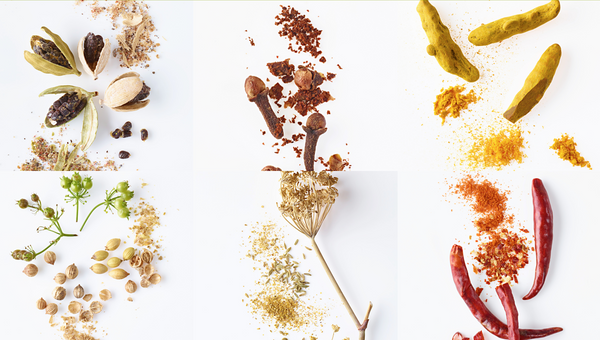
The Indian Spice Pantry
It's no secret that spices are an integral part of Indian cuisine, used all over the country in different and unique ways every day. The climate and terrain make India the perfect setting for all kinds of spices to grow and flourish and allow India to be one of the world's largest spice exporters.
But more so than being the perfect environment for spices to grow, spices are celebrated in India on a daily basis and are used in nearly every meal. You will often see layers of spices added to dishes in India. Whole spices might be bloomed in fat at the start of a dish. Then, throughout the cooking process, spice blends are added to build flavor as the dish cooks and to add a final finish.
Pan Masala, a spice blend composed of whole spices, seeds, and nuts is sometimes eaten at the end of a meal to cleanse the palate and aid in digestion.
You'll find a dabba in every Indian kitchen. This is a circular metal box filled with a multitude of single spices and spice blends that are used for cooking almost every meal. The dabba often features a garam masala, which is a floral and savory spice blend that's recipe varies from family to family.

Common Spices Used in Indian Cuisine
There are, of course, a plethora of spices used in India. Here are the ones we consider the most essential to Indian cuisine.
TURMERIC
Used for both its flavor and color, turmeric is a key player in many of the spice blends found in India. It has an amazing ability to brighten up the color of any dish it is added to plus it helps thicken sauces and stews because of its natural starchy qualities.
The flavor profiles found in turmeric are bright, floral, slightly sweet, and a little bitter.
CLOVES
Used in Indian cooking to add spiciness and richness to savory foods and sweetness and depth to desserts, cloves are the dried, unripe flower buds of the clove tree. They have a powerful scent and flavor and have a certain sweetness and warmth to them, much like cinnamon, nutmeg, and mace.
They are warm, sweet, and peppery.
CARDAMOM
Used as a whole pod or ground in Indian dishes and spice blends. There are three kinds of cardamom: black, green, and white.
Black cardamom is common in Nepal and has a larger pod with smoky and savory notes. Green is very pungent with slightly sweet, spicy, resinous, floral, and citrus notes. White cardamom is a bleached green cardamon and is softer and more savory in character.
CINNAMON
Probably the most recognizable spice to a Western audience, cinnamon is a key component in bringing sweet, warm notes to Indian dishes. Cinnamon is made from the bark of young tree stems.
FENUGREEK
Both the leaves and seeds of Fenugreek can be found in Indian cooking. The fresh leaves are often chopped and added to naan dough and the seeds bring bittersweet notes to curries and spice blends. Fenugreek has a naturally starchy quality that makes it great for thickening soups, stews, and marinades.
The flavor is often compared to maple syrup or burnt sugar. The seeds are milder and nuttier when toasted.
GINGER
Fresh and dried, whole and ground ginger are both used in Indian cuisine. Its flavors can be used to brighten very savory dishes, so it's often paired with heavy meats and game.
Fresh ginger is very bright and can be overpowering sometimes. Ground ginger is milder but still bright, fresh, and floral, with similar notes to pepper but without the heat.
CUMIN
Although cumin is common in many different cuisines around the globe, India is still the largest producer and consumer of cumin in the world. It adds earthiness and body to soups, daals, and curries.
Cumin seeds are nutty, peppery, meaty, and savory.
CORIANDER
Coriander comes from the seeds of the cilantro herb but has an entirely different flavor profile.
Indian coriander is sweet and woodsy with a strong aroma and nutty and citrusy notes.
CHILI
Red chilies and chili powder are commonly used in India. Local varieties of red chiles are typically dried and ground into a fine powder. They are used to add a layer of heat to dishes as well as a bright red color.


